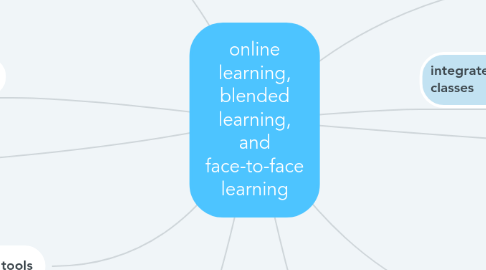
1. accessibility
1.1. improvement
2. technology
2.1. It's good for skills development of both professors and students.
2.2. Technologies used nowadays are still limit, which negatively affect people learning outcome and attitude to online learning.
2.3. acceptance rates are different among different range of people.
2.4. technical difficulties
2.5. development detention
2.6. Slow adoption and or actively resisted
3. Student success tools
4. pedagogy
4.1. qualilty
4.2. design is a challenge
4.3. change resistance
4.4. learning theories
4.4.1. Cognitivism would most likely be resistance to change from in class setting due to missing important nonverbal content.
4.4.2. “Constructivism learning theory are more likely to use computers and use them more often” Kadel, 2005.
5. Further Questions
5.1. How can we share findings and show the effectiveness of online learning? If these are known, how else can doubts be addressed? (Amelia)
5.2. How can learning design as a discipline better connect with other discipline and build more collaborative research environments? (Wesson)
5.3. Are there equal benefits for both the students and instructors in this online learning atmosphere? If so, what are they? (Nickola)
5.4. Support for teachers and online learning
5.4.1. How can we allow for the instructors to feel supported and comfort to make the transition to investing in online courses equally as much as the in class instruction? (Nickola)
5.4.2. How do we ensure that faculty and students have the institutional support necessary for effective online teaching and learning experiences? (Wesson)
5.4.3. What would help higher ed institutions further realize the importance of and increase the demand for professional learning designers? (Andrew)
5.5. Student led support for online learning
5.5.1. How do we guide students to choose the learning environments that best meet their needs? (Wesson)
5.5.2. How can your students help convince you that online and distance learning can be just as effective as an in person presence? (Angxela)
5.6. why is technology in relation to the facilitation of education so taboo? (Andi)
5.7. How can higher education stay relevant if it is unwilling to stay at the forefront of accepting and integrating the technological advances that are moving out society forward? (Andi)
5.8. Do you see a way in which the trend reverses (online learning)? (Ryan)
5.9. Is there a future where educators and society have decided to shun the growing online space in favor of returning to the lecture halls? (Ryan)
5.10. Are we committed to the path and growing use of online learning will slowly subsume more and more of our efforts as educators (Ryan)
5.11. How do we bridge the gap between professors' perception and evidence from literature? (Andrew)
5.12. Should OERs always equate to lesser content quality? How do we improve their quality and close this perception gap? (Andrew)
6. cost vs. value
6.1. Expansion of online learning dependent on investment and adaptation in recognizing the importance of digital pedagogy, updating campus infrastructure, raising awareness about accessibility, universal design, and changing faculty attitudes about the role of technology in the classroom.
6.2. Stigma around online education
7. learning environment preferences
7.1. age
7.2. gender
7.3. employment status
7.4. major
7.5. financial status
7.6. marital status
7.7. learning or physical disability
8. Research
8.1. findings
8.1.1. No difference between online and face-to-face student outcomes
8.1.2. half of faculty who have never taught online are skeptical of whether online learning can produce the same student learning outcomes
8.1.3. majority of students prefer completely or mostly face-to-face instruction.
8.1.4. challenges faced with faculty acceptance of technology use in classroom, reliable Wi-Fi access across campus, and support for accessible technologies.
8.2. limitations
8.2.1. limited sample sizes
8.3. speculation
8.3.1. seems that professors who do not implement online learning maintain their doubts
8.3.2. professors who do implement witness equivalent student learning.
8.3.3. online learning is more flexible and can facilitate a wider type of student demographic than in class
8.3.4. cultural issue creating stigmatization – there seems to be an almost chronic lack of support and enthusiasm as well as lack of rewards given to faculty who implement online modes of delivery
8.4. Next steps
8.4.1. More communication and standardization of research efforts on this topic of discipline
8.4.2. Establishing institutional support in online learning programs, need to reward faculty members for reaching online.
